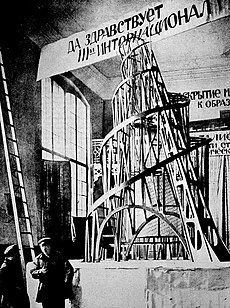
Back عمارة بنائية Arabic Konstruktivizm Azerbaijani Konstruktivismus (Architektur) German Arquitectura constructivista Spanish ساختگرایی (معماری) Persian Architecture constructiviste French אדריכלות קונסטרוקטיביסטית HE 구성주의 건축 Korean Konstruktywizm (architektura) Polish Arquitetura construtivista Portuguese
This article needs additional citations for verification. (July 2022) |

Constructivist architecture was a constructivist style of modern architecture that flourished in the Soviet Union in the 1920s and early 1930s. Abstract and austere, the movement aimed to reflect modern industrial society and urban space, while rejecting decorative stylization in favor of the industrial assemblage of materials.[1] Designs combined advanced technology and engineering with an avowedly communist social purpose. Although it was divided into several competing factions, the movement produced many pioneering projects and finished buildings, before falling out of favor around 1932.[2] It has left marked effects on later developments in architecture.
- ^ "Constructivism". Tate Modern. Retrieved 9 April 2020.
- ^ Hunt, Ronald (1 October 1967). "THE CONSTRUCTIVIST ETHOS: RUSSIA 1913–1932 (PART II)". Artforum. Retrieved 24 February 2024.